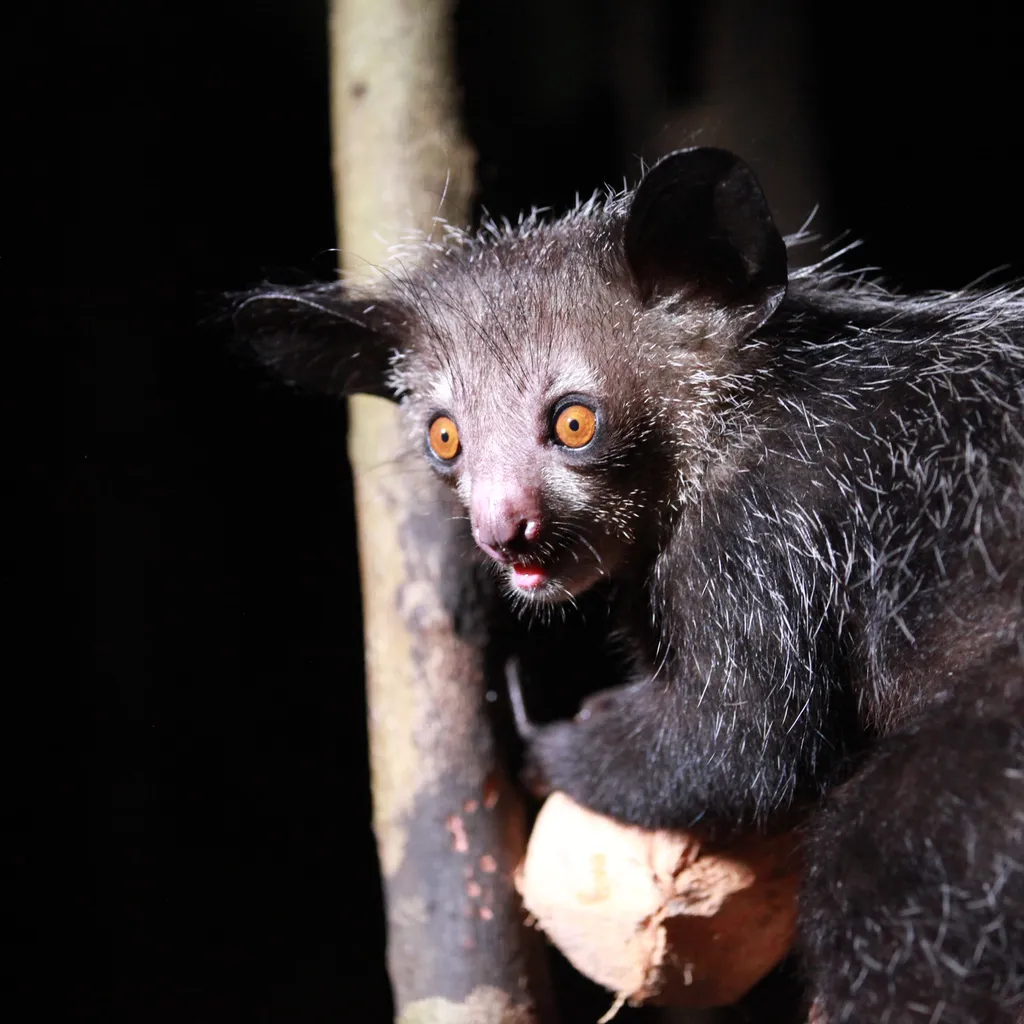Meet the aye-aye, a strange nocturnal creature that lives in Madagascar
What is an aye-aye?
An aye-aye is now accepted as a type of lemur, but it wasn't always that way.
Since its discovery and description in 1788, the aye-aye Daubentonia madagascariensis has been the subject of considerable debate and confusion. The animal was first classified as a squirrel-like rodent on the basis of its appearance.
It was only some 100 years later that the aye-aye was finally accepted as a primate and lemur.
Indeed genetic analysis indicates that the aye-aye, along with all of the other lemurs, evolved from the same colonising ancestor primate, which rafted onto Madagascar about 55–60 million years ago.
There is no question that the aye-aye is the most unusual and distinct offshoot of the lemur evolutionary tree, and it is placed on its own in the family Daubentoniidae. A second species, now extinct, once occurred in the dry regions of south-west Madagascar: the giant aye-aye D. robusta.
How big is an aye-aye?
Aye-ayes measure 74–90cm from nose to tail tip, with the tail making up more than half its length, and weighs roughly 2–2.5kg.
What do aye-ayes look like?
The aye-aye combines a peculiar amalgamation of morphological features and behavioural traits that set it apart. As with rodents, the front teeth (incisors) grow continuously throughout its life. Its ears are massive, mobile and leathery, resembling those of a large bat.
Its extraordinary hands have clawed fingers and a skeletal middle digit, and its mammary glands are low on the torso, between the hind legs. Add widely spaced, piercing orange eyes, a coarse, shaggy black coat and a long, bushy tail, and the overall effect is something resembling an electrocuted witch’s cat with gremlin-like features.
Where do aye-ayes live?
Aye-ayes are only found in Madagascar. They are strictly nocturnal, mainly black, prefer to spend a lot of time high in the canopy, occur at low densities and occupy very large home ranges.
So it is not surprising that there have been few successful wild studies. Eleanor Sterling from the American Museum of Natural History carried out some of the first ground-breaking investigations in the 1980s, and her studies still underpin much of our knowledge of the species in the wild.
“I spent two years on Nosy Mangabe, following aye-ayes throughout the night,” she says. “During the day they sleep high in the canopy in nests made from interwoven twigs and fresh and dead leaves. Nests may be occupied for several days, but there is high turnover and different individuals often use the same nest on different occasions.”
What do aye-ayes eat?
As if its striking appearance wasn’t enough, it is the aye-aye’s feeding habits that really set it apart. It is omnivorous, though insect grubs and ramy nuts Canarium sp. make up 90 per cent of its diet at times. Combining elements of both woodpeckers and squirrels (neither of which are found in Madagascar), it hunts for beetle grubs in rotting wood and uses its bony middle finger (the third digit) to extricate them. In contrast the fourth digit is more robust, so is used for tasks needing more strength such as accessing large fruit, scooping contents and exploring deep recesses.
Indeed most of the aye-aye’s anatomical peculiarities derive from its foraging and feeding adaptations. The roots of its huge, rodent-like teeth extend far back into the jaw, resulting in the unusually wide spacing between the eyes.
The middle finger on each hand is not only excessively thin, but also incredibly flexible and can rotate 360 degrees. Unlike other digits, it articulates through a ball-and-socket joint. The aye-aye also has an unusually large brain relative to the size of its body, a consequence of the complex hand, eye and auditory co-ordination that it requires.
Are aye-ayes social?

Aye-ayes have been regarded as solitary, only coming together when breeding, but Sterling’s findings suggest otherwise. “They actually interact quite a lot outside the mating period. Animals come together in ‘tandem foraging’, often occupying adjacent or nearby trees while feeding.
When one moves to another tree, they call quietly to one another and the second animal relocates nearby. They scent-mark too, telling others where they have been and possibly where to go. There may even be ‘highways’ along branches, routes that animals take and different animals follow on subsequent nights.”
How do aye-ayes mate?
When they become receptive, females scent-mark and are highly vocal, mating with different partners during one oestrus cycle. Each copulation lasts about an hour – a lengthy period for a primate.
This is probably the male’s way of guarding against the advances of other suitors, but the ploy often fails, and the female begins calling again immediately to attract an alternative mate. Females begin breeding when three or four years old, and there is a three-year interval between births. Infants remain with their mother for a long period, allowing them to learn the complex foraging techniques needed for survival.
How long do aye-ayes live for?
Their lifespan ranges from 10 - 23 years
What is the conservation status of aye-ayes?
The IUCN list the aye-aye as endangered, with a decreasing population
Learn about other different primate species
- Ring-tailed lemur guide: where they live, what they eat, and why they're endangered
- Hainan gibbon guide: where they're found, and why they're so rare
- Bonobo guide: where they live, how they’re related to chimps, and why they have such a fascinating society
- Chimpanzee guide: where they live, what they eat, and how they use tools and weapons